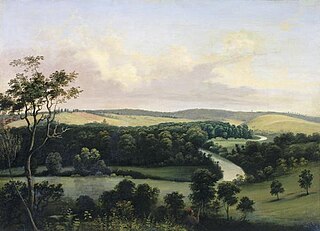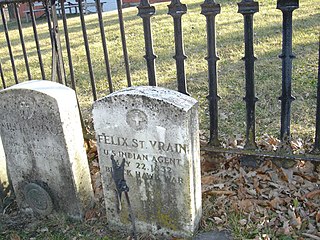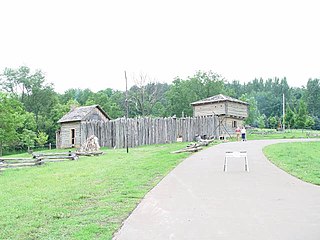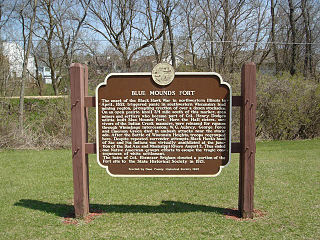Fort Union was a frontier fort at Dodgeville, Wisconsin, United States, during the 1832 Black Hawk War. It served as military commander Henry Dodge's headquarters during that war.

Fort Union was a frontier fort at Dodgeville, Wisconsin, United States, during the 1832 Black Hawk War. It served as military commander Henry Dodge's headquarters during that war.

Henry Dodge, who became known as a military commander during the Black Hawk War first located in Wisconsin in 1827 where he established a lead smelting operation. His settlement became known as Dodgeville and during the 1832 Black Hawk War Fort Union was constructed. [1] Fort Union served as Dodge's headquarters during the war. [2]

Dodgeville is a city in and the county seat of Iowa County, Wisconsin, United States. The population was 4,984 at the 2020 census, making it the county's most populous city. Dodgeville is part of the Madison Metropolitan Statistical Area.

Moses Henry Dodge was an American politician and military officer who was Democratic member to the U.S. House of Representatives and U.S. Senate, Territorial Governor of Wisconsin and a veteran of the Black Hawk War. His son, Augustus C. Dodge, served as a U.S. Senator from Iowa; the two were the first and so far the only father-son pair to serve concurrently in the Senate, which they did from 1848 to 1855.

Fort Koshkonong was a military fort located near the present-day city of Fort Atkinson, Wisconsin. Intended to control the confluence of the Bark and Rock rivers, it was used as a station for local militia units and the U.S. regulars in the region to scout the British Band, a group of Native Americans who fought against government units during the 1832 Black Hawk War. General Henry Atkinson was the commander of the fort during the war. Black Hawk was in the same general area, but evaded capture and started to flee towards the Wisconsin River. The original fort was abandoned by the Army following the conflict. Local settlers dismantled it for the wood as the town developed.

The Bad Axe Massacre was a massacre of Sauk (Sac) and Fox Indians by United States Army regulars and militia that occurred on August 1–2, 1832. This final scene of the Black Hawk War took place near present-day Victory, Wisconsin in the United States. It marked the end of the war between white settlers and militia in Illinois and Michigan Territory, and the Sauk and Fox tribes under warrior Black Hawk.

The Military Ridge State Trail is a 40-mile (64 km) long, recreational rail trail in Wisconsin.

The Battle of Horseshoe Bend, also referred to as the Battle of Pecatonica and the Battle of Bloody Lake, was fought on June 16, 1832 in present-day Wisconsin at an oxbow lake known as "Horseshoe Bend", which was formed by a change in course of the Pecatonica River. The battle was a major turning point in the Black Hawk War, despite being of only minor military significance. The small victory won by the U.S. militia at Horseshoe Bend helped restore public confidence in the volunteer force following an embarrassing defeat at Stillman's Run. The Battle of Horseshoe Bend ended with three militia men killed in action and a party of eleven Kickapoo warriors dead.

The Spafford Farm massacre, also referred to as the Wayne massacre, was an attack upon U.S. militia and civilians that occurred as part of the Black Hawk War near present-day South Wayne, Wisconsin. Spafford Farm was settled in 1830 by Omri Spafford and his partner Francis Spencer.

The St. Vrain massacre was an incident in the Black Hawk War. It occurred near present-day Pearl City, Illinois, in Kellogg's Grove, on May 24, 1832. The massacre was most likely committed by Ho-Chunk warriors who were unaffiliated with Black Hawk's band of warriors. It is also unlikely that the group of Ho-Chunk had the sanction of their nation. Killed in the massacre were United States Indian Agent Felix St. Vrain and three of his companions. Some accounts reported that St. Vrain's body was mutilated.

The Battle of Apple River Fort, occurred on the late afternoon of June 24, 1832 at the Apple River Fort, near present-day Elizabeth, Illinois, when Black Hawk and 200 of his "British Band" of Sauk and Fox were surprised by a group of four messengers en route from Galena, Illinois. One of the couriers was wounded in the thigh as the riders quickly made for the protection of the nearby stockade. Courier Fred Dixon lagged behind and provided cover for his comrades. The other couriers rode ahead to warn some 70 settlers of the approaching Sauk and Fox, thus saving their lives. The small company of militia at the fort, about 28-30 men and boys led by Captain Clack Stone, fought off Black Hawk's 150-man war party in an action that lasted about an hour. The withering pace of the gunfire eventually convinced Black Hawk that the fort was too heavily defended to lead a direct attack. He considered burning the fort, then switched to raiding cabins of foodstuffs, clothing and cooking utensils. In the gathering darkness, Black Hawk and his war party retreated.

The Battle of Wisconsin Heights was the penultimate engagement of the 1832 Black Hawk War, fought between the United States state militia and allies, and the Sauk and Fox tribes, led by Black Hawk. The battle took place in what is now Dane County, near present-day Sauk City, Wisconsin. Despite being vastly outnumbered and sustaining heavy casualties, Black Hawk's warriors managed to delay the combined government forces long enough to allow the majority of the Sauk and Fox civilians in the group to escape across the Wisconsin River. This reprieve was temporary; when the militia finally caught up with the fleeing band it resulted in the Bad Axe massacre at the mouth of the Bad Axe River.

The attacks at Fort Blue Mounds were two separate incidents which occurred on June 6 and 20, 1832, as part of the Black Hawk War. In the first incident, area residents attributed the killing of a miner to a band of Ho-Chunk warriors, and concluded that more Ho-Chunk planned to join Black Hawk in his war against white settlers. The second incident occurred east of the fort as a Sauk raiding party, estimated by eyewitnesses to be as large as 100 warriors, attacked two militiamen who were investigating noises heard the night before. Two members of the militia stationed at Blue Mounds were killed in the attack, and both their bodies were badly mutilated.
The Sinsinawa Mound raid occurred on June 29, 1832, near the Sinsinawa mining settlement in Michigan Territory. This incident, part of the Black Hawk War, resulted in the deaths of two men; a third man survived by seeking cover in a nearby blockhouse. In the aftermath of the raid, Captain James W. Stephenson set out to pursue the attackers—a straggling band of Sauk Native Americans—but lost their trail at the Mississippi River. The attack occurred in the same week as other skirmishes and raids, and as a result helped contribute to the growing fear in the region. The raid caused the residents of nearby Platteville to consider fleeing their settlement.
James D. Henry was a militia officer from the U.S. state of Illinois who rose to the rank of general during the Black Hawk War. Henry was born in Pennsylvania in 1797, and moved to Edwardsville, Illinois in 1822. In 1825, while living in Edwardsville, he was indicted with two other men for the murder of an acquaintance, though he never went to trial. One defendant was tried but found not guilty, and following the trial Henry moved to Springfield, Illinois, where he was elected sheriff. When the Winnebago War broke out in 1827 Henry acted as adjutant for four companies of volunteers.

John Dement was an American politician and militia commander from the U.S. state of Illinois.

The British Band was a mixed-nation group of Native Americans commanded by the Sauk leader Black Hawk, which fought against Illinois and Michigan Territory militias during the 1832 Black Hawk War. The band was composed of about 1,500 men, women, and children from the Sauk, Meskwaki, Fox, Kickapoo, Potawatomi, Ho-Chunk, and Ottawa nations; about 500 of that number were warriors. Black Hawk had an alliance with the British that dated from the War of 1812, giving them their colloquial name. The band crossed the Mississippi River from Iowa into Illinois in an attempt to reclaim their homeland and in violation of several treaties. Subsequently, both the Illinois and Michigan Territory militia were called up and the Black Hawk War ensued.
William Stephen Hamilton, a son of Alexander Hamilton and Elizabeth Schuyler Hamilton, was an American politician and miner who lived much of his life in the U.S. state of Illinois and the Wisconsin Territory. Hamilton was born in New York, where he attended the United States Military Academy before he resigned and moved to Illinois in 1817. In Illinois he lived in Springfield and Peoria and eventually migrated to the lead-mining region of southern Wisconsin and established Hamilton's Diggings at present-day Wiota, Wisconsin. Hamilton served in various political offices and as a commander in two Midwest Indian Wars. In 1849 he moved to California during the California Gold Rush. He died in Sacramento, most likely of cholera, in October 1850.
After the outbreak of the Black Hawk War, at the Battle of Stillman's Run in May 1832, there were minor attacks and skirmishes throughout the duration of the conflict. The war was fought between white settlers in Illinois and present-day Wisconsin and Sauk Chief Black Hawk. The relatively minor attacks of the war were widely dispersed and often carried out by bands of Native Americans that were unaffiliated with Black Hawk's British Band.

Helena is an unincorporated community in the town of Arena in Iowa County, Wisconsin, United States. In the 19th century Helena was a village that played an important role in the manufacture and shipping of lead shot. The buildings of Helena played a key role in the Black Hawk War of 1832, despite being abandoned at the time.
Ebenezer Brigham was a 19th-century American pioneer, businessman, and politician. He was one of the first Americans to explore southwestern Wisconsin and the first permanent settler in present-day Dane County, Wisconsin. A militia officer during the Black Hawk War, he served as commander of Fort Blue Mounds and was active in both the Wisconsin territorial council, and the Wisconsin State Assembly during the 1840s and 1850s.
Fort Jackson was a frontier fort located in Mineral Point, Michigan Territory, and constructed during the 1832 Black Hawk War.
Coordinates: 42°54.978′N90°7.084′W / 42.916300°N 90.118067°W